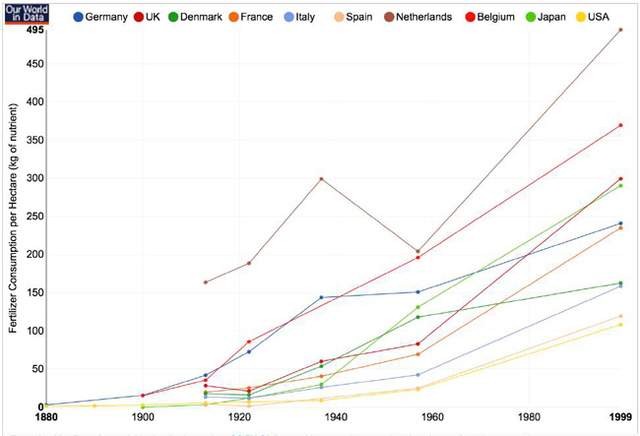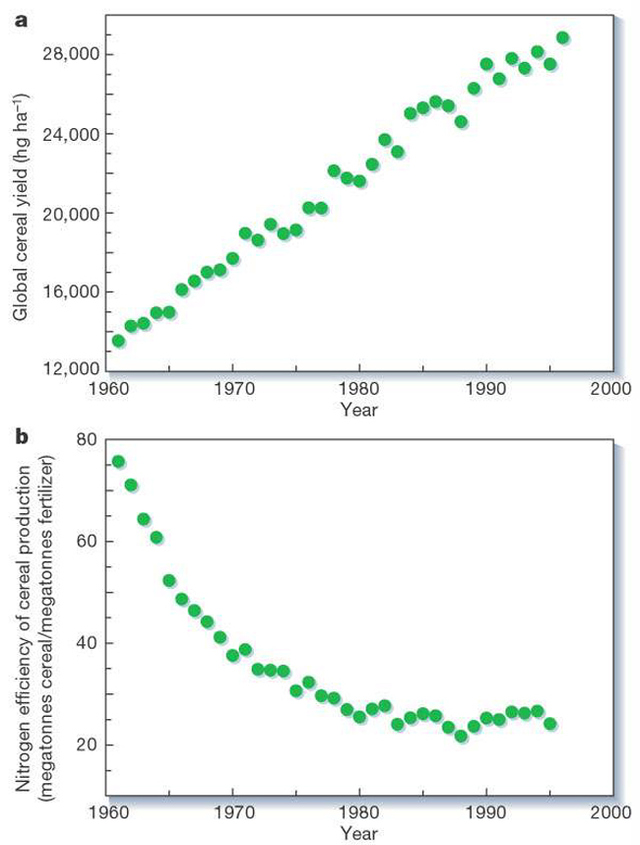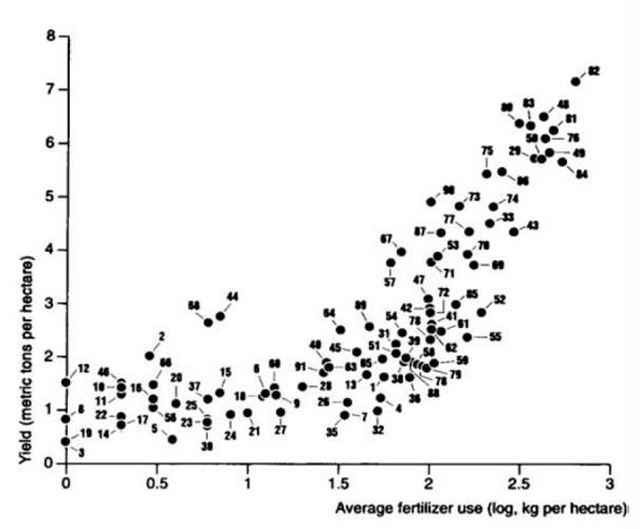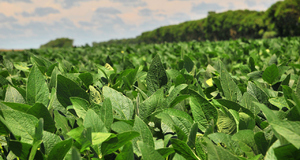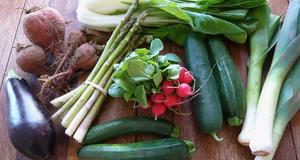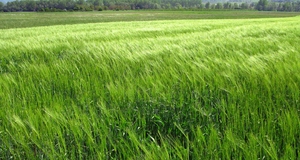From Center for Development and Strategy VOL. 2016 NO. 1Effects of Conventional and Organic Agricultural Techniques on Soil Ecology
IN THIS ARTICLE
AbstractThis paper explores the differing effects that conventional and organic agriculture have on soil ecosystems. The findings are primarily based on a review of published literature found in journal articles and government reports. Conventional agriculture is found to generally have higher yields than organic agriculture. However, the monetary benefits of high yielding conventional agriculture systems use monoculture cropping, tilling, pesticides, and fertilizers that have a significant negative effect on the natural processes soil ecosystems. As a result, these natural process need to be replaced by the continual and increased use of external inputs such as pesticides and fertilizers which present issues from a sustainability perspective. Furthermore, conventional agriculture is a main culprit of soil loss. This paper explains intricate relationships between soil organisms and argues for an increase in the use of organic agriculture strategies to maintain healthy soil in the long term. The paper focuses on the relationship between soil ecosystems and the following: tilling, pesticides, biodiversity, fertilizers. The effects of these relationships are explored in terms of yield, resource use, and sustainability. The conclusion is that when all costs are considered, organic agriculture is at least competitive with conventional agriculture systems. IntroductionSoil is an important natural resource on Earth. Soil performs an essential function in terrestrial ecosystems and forms the base of a food chain, where primary producers grow and access nutrients and water. Healthy soil contains an immense diversity and abundance of organisms that perform ecological services. As such, it is essential that soil is cared for, maintained, and respected, specifically in agriculture. Unfortunately, the dominating conventional, monoculture agricultural systems use strategies and technology which can negatively impact the life in soil. Therefore, understanding how soil ecosystems work with plants is important for human decision making in moving towards more sustainable and ecologically sound agriculture. Organic agriculture offers an alternative to conventional monoculture agriculture systems. The main differences between organic and conventional agriculture are the use of tillage methods, pest control methods, and fertilizers, and the consequent effects on biodiversity, yields, sustainability and resource use. This paper explores the fundamental processes of soil ecosystems in each of these differences. Through an extensive literature review, this paper argues that conventional agriculture has significant negative effects on soil ecology, and organic agriculture is at least as competitive with conventional agriculture when externalized costs are considered. Background AnalysisOver thousands of years, humans have learned how to domesticate the plants which provide both the necessities for our diet and the products for our lifestyles. This domestication brought about the agricultural revolution, which was a large step towards what some might term as humanity's domination of nature and the subsequent development of our first civilizations. As time passed, economies became increasingly mechanized with technological advances made during the industrial revolution. The ways in which plants are were grown became an issue of efficiency, output, and productivity. This shift, along with new ways of increasing plant growth through fertilizer use and pest control, led to the green revolution. Throughout the world, production costs were reduced while yields increased, primarily through the planting and cultivating of vast tracts of land with homogenous crops, organized in rows for easier harvesting, maintenance, and control. This is now the established method of planting called conventional farming or monoculture. The prefix "mono" refers to "one", "only", or "single". The word "culture" in the context of farming or planting refers to the cultivation of a piece of land. Because of the wide variety of soil types, agricultural strategies, fertilizers, pesticides, and research methods used in agricultural studies, there is a diversity of research on this subject. Many studies are limited to researching the effects of specific pesticides on specific plants and soil types. Some studies present conflicting evidence of the benefits and costs of organic and conventional agriculture in comparison to other studies. Literature reviews that have drawn conclusions based on the analysis of significant amounts of research are especially valuable. The references used in this paper are diverse and numerous in order to present a broad comparison between conventional/monoculture agriculture and organic agriculture. Very little is known about communities of soil microorganisms (Dance, 2008). This is because of the extreme diversity and abundance of soil microorganisms. A 2007 study aimed to resolve the differences between existing estimates of the number of bacteria species per gram of soil that had ranged from 2,000 to 8.3 million. The study concluded that the average number of unique species in a gram of soil was closer to 52,000 through studying ribosomal RNA sequences (Roesch, 2007). This study only considered bacteria. Other types of organisms are ! ! 5 abundant as well. A study found that one cup of undisturbed soil contained 200 billion bacteria, 20 million protozoa, 100,000 metres of fungi, 100,000 nematodes, and 50,000 arthropods (Moravec et al, 2014). Science does not have a thorough understanding of soil ecology due to the numbers of species and organism interactions. Only a small percentage of soil organisms is known, documented, and studied. The interactions of soil organisms that have been studied have been shown to be complex (Ingham, 2015). Conventional agriculture encompasses the idea that humans can bypass these complex natural systems and develop superiorly efficient systems through the use of tilling, pesticides, monocultures, and fertilizers. TillingTilling has a variety of purposes. It is used to loosen and aerate the soil, kill weeds, dry out soil after wet winter seasons, and mix organic matter into the soil. There are various ways to measure the effect of plow tillage on soil. Cone penetration testing is a method used in determining soil stratigraphy which is the variation in soil composition with depth. It is done by pushing a cone through soil at a constant pressure, thereby measuring soil penetration. Studies by Alvarez and Steinbach (2009) showed that soils that are not tilled after harvest or before planting (no till) can have 50% higher penetration than plow tillage. They also tested bulk density, an indicator of soil compaction, and found that non tilled soils had less compaction compared to plow tillage. Soil penetration, compaction, and density are important determinants in soil ecology. Grant (1993) explains that compaction increases soil resistance to root extension. Soil compaction also reduces overall porosity, limiting oxygen movement to root surfaces which is required for carbon respiration and nutrient uptake. The increased compaction and density of soil resulting from plowing hinders the growth of roots and affects the ability of microorganisms to provide nutrients to plants because of limited oxygen. Tillage also affects aggregate stability in soils. Aggregate stability measures the ability of soil to resist disintegrating when disruptive forces such as plow tillage and water/wind erosion come in contact. When aggregate stability is high, it means organic matter content, biological activity, and nutrient cycling in soil are at healthy levels (Andrews & Wander, 2008). When comparing no till to plow tilled soils, Alvarez and Steinbach (2009) found that aggregate stability is higher in non-tilled soils and 70% higher in certain soil types. This indicates that plowing negatively affects levels of organic matter content, biological activity, and nutrient cycling and is disruptive to the soil ecosystem. Soil compaction also affects how water interacts in soil ecosystems. Lipiec and Hatano (2003) explain that saturated hydraulic conductivity, which measures the ease with which water infiltrates pore spaces or fractures, is drastically reduced in compacted soil. In fact, the water infiltration in no till can be twice as high compared to low tillage (Alvarez & Steinbach, 2009). The reduction of saturated hydraulic conductivity in soil also results in increased water runoff and erosion. To exacerbate the issue, tractors, which are used to plough the soil and distribute pest control and fertilizer, further compact soil into ruts from the tires. Studies show that these traffic ruts are the main source of soil erosion and runoff even though they only make up 5% of the surface of a field (Fleige & Horn, 2000). Soil erosion and water runoff could be drastically reduced by no till methods. This would decrease sedimentation and the levels of fertilizers causing eutrophication in aquatic ecosystems and replenish water tables and aquifers. Tilling greatly influences the biology in soils (Gomiero et al, 2011). Earthworms have been regarded as a useful indicator of soil fertility but have largely been displaced in farmland soils because tilling exposes them to predation from birds (Paoletti, 1999). No till, or minimum till soils tend to reduce the loss of earthworm biomass. Studies have confirmed this by highlighting a significant difference in the abundance of earthworms found in non tilled soils than under conventional tilling (Capperton et al, 1994). After healthy soil is tilled, worms become exposed to the outside air which attracts birds as shown in figure 1. A specific soil layer that is affected by tillage is the rhizosphere. This is the region where plant roots associate with various fungi and bacteria. In the rhizosphere, the mycorrhizae process occurs. Mycorrhizae is the symbiotic relationship between plants roots and fungi where a plant provides carbohydrates derived from photosynthesis to arbuscular mycorrhizal fungi. In return, the arbuscular mycorrhizal fungi, which can extend beyond the plant's roots, have access to more surface area and provide the plant roots with various minerals. This is shown in figure 2 (Aitken, 2015). The arbuscular mycorrhizal fungi have higher absorption capacity for water and can convert phosphorus minerals into a form that is useable to plants. This mycorrhizae symbiotic relationship is essential for a plant's health, specifically in the uptake of nutrients (Balzergue et al, 2011), (Kabir, 2005). Tilling has been shown to affect the colonization of arbuscular mycorrhizal around the rhizosphere which affects the plant's uptake of water and minerals (McGonigle et al, 1999). Under no till systems, arbuscular mycorrhizal survive at higher rates. Furthermore, when fields are not tilled, arbuscular mycorrhizal can follow old root channels and encounter other arbuscular mycorrhizal to form networks that create more effective nutrient channels (Kabir, 2005). Kabir (2005) notes that conserving arbuscular mycorrhizal is essential for maximizing benefits to crops and is also important for maintaining aggregate soil stability. Organic farming tends to use no till methods for soil management because of the reasons explained above. But these reasons have not always been known to science. The National Oceanic and Atmospheric Administration (NOAA) (2015) explains that the dustbowl of the 1930s in the American Great Plains was due not only to a multi year drought, but also to land management practices which aimed to maximize agricultural production though intensive tillage methods. The US Department of Agriculture reports that no-till farming is growing in the United States at around 1.5% per year (Plumer, 2013). This is due to new technology in seeding techniques, and government subsidies for soil conservation. However, only 10% of American Agriculture uses no-till techniques. The worldwide percentage of no till agriculture is even smaller, with Europe, Asia, and Africa making up only 15% of the world's no till acreage as seen in figure 3. PesticidesThe United Nations Food and Agriculture Organization (UNFAO) defines pesticides as follows: "Pesticides refer to insecticides, fungicides, herbicides, disinfectants and any substance or mixture of substances intended for preventing, destroying or controlling any pest, including vectors of human or animal disease, unwanted species of plants or animals causing harm during or otherwise interfering with the production, processing, storage, transport or marketing of food, agricultural commodities, wood and wood products or animal feedstuffs, or substances which may be administered to animals for the control of insects, arachnids or other pests in or on their bodies. The term includes substances intended for use as a plant growth regulator, defoliant, desiccant or agent for thinning fruit or preventing the premature fall of fruit, and substances applied to crops either before or after harvest to protect the commodity from deterioration during storage and transport." (UNFAO, 2013)" This definition is indicative of an anthropocentric view of nature within the agricultural industry. The very existence of an abundance of pests is indicative of an unbalanced ecosystem. When these pests interfere with the production, processing, storage, transport or marketing of food, it is seen as harmful. But when human agriculture activity affects the production, processes, and the health of soil itself, there are not necessarily immediate monetary losses. The losses are only recognizable in the long run. The result is dirt, which is soil that has become devoid of life. Pesticides are a crude and simple, yet effective way to eliminate pests. However, many beneficial soil organisms are unintentionally killed at the same time. Numerous studies confirm the effect that pesticides have on beneficial soil organisms (Bunemann et al, 2006) (Friedrich, 2005) (Gomeiro et al, 2011) (Makawi, 1979) (Merrington et al, 2002) (Smith et al, 2000). However, there are hundreds of thousands of different pesticides and not all of them have been studied. The Pesticide Action Network (2014) has a list of more than 375,000 current and historical chemical pesticides registered in the United States alone. As a result, upon studying literature reviews of the effects of pesticides, there is a lack of comprehensive data showing the overall effects of pesticides and their long term effects on soil health (Bunemann et al, 2006). Furthermore, some of the research that has been done on pesticides is kept confidential by chemical companies. Regardless, studies exist that show effects of specific pesticides on specific organisms and even the broader effects of pesticides. For example, one study showed that pesticides in general will sharply depress the counts of azotobacter and clostridia microorganisms (Makawi et al, 1979) which are especially important for providing nitrogen to plants. The abundance of pesticide types makes researching the broad topic difficult, although literature reviews have been completed in an attempt to assess categories of pesticides including herbicides, insecticides, and fungicides. Herbicides, which are used to control weed growth, had little to no effects on soil biology, although some herbicides have been found to be toxic to earthworms and also affect the enzyme activity in microorganisms (Bunemann et al, 2006). Studies show that no till farming requires the use of more herbicides because weeds are not disturbed since the soil is not turned over (Teasdale et al, 2007). However, other studies indicate that integrated pest management strategies that do not use any chemicals have been demonstrated successfully. It is more of a lack of awareness and understanding that leads farmers to believe that no till farming requires more herbicides (Friedrich, 2005). Insecticides have a much greater effect on the soil biology than herbicides. Organophosphate insecticides such as chlorpyrifos have been shown to have a significant impact on bacterial populations. The application of this insecticide reduced bacterial populations by 53.4% after 15 days and then a further 70.6% after 30 days. It took 120 days for the populations to return to normal rates comparable to the control (Pandy & Singh, 2004). Fungicides are found to have an even more significant impact than herbicides or insecticides. While fungicides are meant to stop fungal disease, they also affect beneficial soil bacteria. Fungicides that contain copper have been shown to accumulate in soils and significantly reduce and stress microbial biomass. These copper residues accumulate in soils because they cannot dissipate from biodegradation, this has long term negative effects on soil (Merrington et al, 2002). Other studies show how beneficial fungi, such as arbuscular mycorrhizal are significantly affected by fungicides. Smith et al. (2000) found an 80% decrease in arbuscular mycorrhizal root colonization from benomyl fungicide application. With less arbuscular mycorrhizal fungi, the bacterial biomass, abundance of fungal-feeding, and predatory nematodes were reduced by 20, 12, and 33% respectively. The absence of normal bacteria levels for significant periods of time (almost 4 months) coupled with the absolute losses of beneficial fungi, means plants are not receiving the ecological service that these bacteria and fungi provide. One of these services is protecting plants from diseases and pests. In Symphony of the Soil, Ingham (2013) explains that plants excrete exudates into the soil through their roots to promote the growth of bacteria and fungi. These exudates are made of simple sugars, proteins, and carbohydrates that attract bacteria and fungi that the plant needs. When the bacteria and fungi are killed by pesticides, they cannot defend the plant from disease and pests. When plants are more susceptible to disease and pests because of the absence of bacteria and fungi defenses, disease and pests are able to spread more quickly. The response might be to add more pesticides. This can become a vicious positive feedback loop as the application of pesticides can lead to the need for more and more pesticide application. Another ecological service that is forgone without bacteria and fungi is providing plants with nutrients (Smith et al, 2000), and this absence of nutrients then results in the need to apply artificial fertilizers. This will be further explored in later sections. The impact of pesticides on soil health as well as other ecosystems is becoming more apparent. In addition, the use of pesticides is an extremely inefficient process as only a small fraction of the pesticide reaches the intended target while the rest is effectively wasted (Aselage et al, 2009). This extra pesticide reaches untargeted environments such as ground and surface waters and distant terrestrial ecosystems (Aselage et al, 2009). Farmers who are aware of these issues are searching for alternatives. A promising alternative is integrated pest management (IPM) which uses natural predators, pest resistant plants, and other strategies to maintain yields and healthy soils without using pesticides. A major IPM strategy is intercropping, interplanting, and polycultures, which increase the biodiversity of agriculture ecosystems. Regardless, pesticide production and imports are expected to continue growing based on historical trends shown in figure 4 (Tillman et al, 2002). Figure 4: Total global pesticide production and global pesticide imports 1940s-2000 Source: Tillman et al, 2002 Biodiversity and MonoculturePart of the reason pesticides are needed and used in conventional monoculture methods is because there are lower levels of biodiversity in these systems. Monocultures are more vulnerable to pests because homogeneous and simplified ecosystems are weak and less resilient. The higher levels of microbial activity and biodiversity associated with organic agriculture enhance nutrient balance in plants which increases the plants ability to respond to pests (Phelan et al, 1996). Furthermore, pests cannot cause as much damage in organic systems because there are more predators that can keep the level of pests in balance. These characteristics of monoculture systems make them inherently vulnerable to pests. This point is argued by Naeem et al. (1994) who found that reduced biodiversity alters the performance of ecosystems. This particular study measured five factors including community respiration, decomposition, nutrient retention, plant productivity, and water retention. All of these factors increased with higher levels of biodiversity. The application of pesticides, as explained previously, will harm the life in the soil. With less biodiversity, plant productivity decreases. This is counterintuitive to the ultimate goal of agriculture which is to produce plants in the most cost effective and sustainable way. Conversely, without using pesticides, organic agriculture, while still using row cropping to some extent, usually increases species richness with 30% higher levels of species compared to conventional agriculture (Bengsston et al, 2005). The study showed increase richness and heterogeneity of birds, insects, plants and soil organisms. Not only is species diversity increased in organic agriculture, but organisms are 50% more abundant as well. The abundance of birds, insects, plants and soil organisms all increased while pests did not (Bengsston et al, 2005). However, this finding was limited to organic agriculture on smaller sized plot and field scales while effects were less significant for larger agricultural areas. The study noted that species diversity and abundance were dependant on intensively managed agricultural landscapes. In other words, large farming plots that are comprised of hundreds of hectares of land would have less diversity and abundance. Bengsston et al. (2005) suggest that measures to preserve and increase organism biodiversity and abundance should be farm and landscape specific. This type of strategy is contradictory to the standard accepted strategies of conventional agriculture which favour universal models that are convenient for replication and mass scalability. FertilizerThe use of fertilizers in agriculture has increased productivity significantly since they were introduced in the 1930s in the developed world and in the 1960s in the developing world. The use of fertilizers in developed countries is show in figure 5 (Roser, 2008). Synthetic fertilizers were part of the technology that contributed to the Green Revolution. The dramatic increase in worldwide agricultural productivity significantly reduced starvation rates in the developing world (Lal, 2009). Synthetic fertilizers have been and continue to be beneficial in that regard but they also have negative effects on soil ecosystems. Figure 5: Fertilizer consumption per hectare in developed countries over the long run. Source: Roser, 2008 All living things require nutrients. In any type of agriculture, carbon, nitrogen, potassium, and phosphorus are critical nutrients for growing and fruiting. There are also a number of important trace elements such as sulphur, magnesium, calcium, iron, zinc, and copper. The relevant difference in conventional and organic agriculture is how plants access these nutrients and minerals. In conventional agriculture, synthetic chemical fertilizers are applied and in organic agriculture, organic matter and compost are applied. Understanding how nutrient cycle through ecosystems is important for determining how plants take up nutrients from soil ecosystems. Soil is the biggest terrestrial reservoir of carbon, another essential element needed by plants and soil ecosystems (Murck et al. 2013). Carbon is taken into plants through photosynthesis where carbon dioxide in the atmosphere is converted to sugars and starches, becoming part of the plant's carbon based organic matter. This organic matter is returned to the soil when the plant dies, or drops its leaves, and feeds decomposing organisms and bacteria. Carbon can remain in the soil for thousands of years and is also emitted back into the atmosphere in significant amounts through soil respiration of carbon dioxide (Gaudinski, JB et al, 1995). Nitrogen is a basic building block of life and promotes growth in plants. It is abundant in the atmosphere but plants cannot use it in a gaseous state. Specialized bacteria have developed symbiotic relationships with certain plants to combine nitrogen gas from the atmosphere with hydrogen ions to form ammonium or NH4+. This is a form of nitrogen that plants can use. The specialized bacteria that provide this ecological service live freely in the soil and in the root nodules of leguminous plants and some other plants. This natural cycle has been used in an industrial form by humans as the Haber-Bosch process, developed in 1909 (Murck et al, 2013). This process converts atmospheric nitrogen into ammonia, by reacting nitrogen (N2) to ammonia (NH3) by a reaction with hydrogen (H2) using a catalyst at high temperatures. The industrialization of this process has doubled the rate of nitrogen input into the terrestrial nitrogen cycle, which has caused losses in other soil nutrients, increased the acidification of soils and aquatic systems, and caused biodiversity loss especially in plants that have adapted to the efficient use of nitrogen (Vitousek et al, 1997). The phosphorus cycle is another major part of soil ecosystems. The phosphorus cycle is relatively slow compared to other cycles because it is usually trapped in rock sources and then eroded over time into soils. Plants take up phosphorus from the soil and it is transformed into organic matter. Animals will eat plants and the phosphorus can become part of their system or be excreted back into the environment. Over time, phosphorus minerals will be washed into oceans and will accumulate into sedimentary layers. Over longer periods of geologic time, these rocks will become exposed to terrestrial environments and once again repeat the process. In organic agriculture, phosphorus is added to soil in the form of manure while in conventional agriculture, phosphorus in added through fertilizers derived from mined phosphorus. The potassium cycle is similar to the phosphorus cycle and is the final nutrient cycle discussed in this report. Potassium is an essential nutrient for plant functions such as carbohydrate metabolism, enzyme activation, and protein synthesis. Potassium is also important in the growth of the edible parts of plants such as grains and tubers (University of British Columbia, (2015). Potassium is a highly reactive alkali metal and is usually bonded with sodium to form salt deposits commonly known as potash. Similar to phosphorus, potash is mined from the earth. Potash deposits are formed when inland seas evaporate and salt layers remain. Parts of Saskatchewan were covered by an inland which dried around 400 million years ago to form one of the world's largest potash deposits (Ladurantaye, 2010). Both potassium and phosphorus based fertilizers are essentially non-renewable resources as their formation is based on long geological time scales. In conventional agriculture, chemical fertilizers are needed because the soil has been depleted of the biota that are necessary for transporting nutrients and minerals to plants in an accessible form. These biota, including bacteria, fungi, and nematodes, are harmed by the tilling and pesticide use that is so common in conventional agriculture systems. Without these biota, important ecological services that are essential to healthy plants are not available. Nitrogen, potassium, and phosphorus agricultural fertilizers have been developed in a form that plants can readily access and which bypass the ecological services provided by the soil biology. This presumably makes the various biology in the soil ecosystem less important. However, as explained in the previous section, discussing the rhizosphere, plants need the soil biota to provide other trace minerals and nutrients that are not as readily available in synthetic chemical form. The trace minerals and nutrients exist in the soil already but are only made available to plants through their relationship with the beneficial fungi and bacteria (Ingham, 2015). Fertilizers do effectively increase plant growth. However, compost application is a viable substitute for fertilizer when there is access to large quantities. Large quantities of compost are a limiting factor and may be out of reach to many agricultural ventures trying to cut back on fertilizer use. Nitrogen, is found to be the limiting nutrient when compost is used in place of nitrogen, phosphorus, and potassium fertilizers (Evanylo et al, 2008). However, the compost provides benefits that fertilizers do not. Compost tends to improve the physical properties of soil such a bulk density, porosity, and water holding capacity. The compost amended soils reduce mineral and sediment runoff. Evanylo et al. (2008) also showed that compost increased the rate of carbon sequestered in the soil. It is important to note that the various benefits of using compost accrue over time and are not realized until compost has been applied for a number of years. This could be a major issue for farmers who are struggling with marginal returns and need to maximize yields to make a steady income. Earthworms, an indicator of soil health, are also affected by fertilizer use. Organic matter and compost are food sources for worms and are essential to their survival. Earthworms respond better to organic manure and compost than to chemical fertilizers (Paoletti, MG, 1999). Because worms eat dead organic matter and compost, the application of compost in agricultural settings will promote earthworm biomass. When worms are present in soil, their waste creates highly fertile worm castings. The ecological service that worms perform is becoming increasingly recognized for the soil improvement without the risk of pathogens or other polluting substances. Furthermore, worms have been found to eliminate harmful chemical substances and heavy metals which also improve the the quality of polluted soils (Iozon et al, 2003). Worm castings are also shown to increase yields and fruiting quality of certain plants (Panicker et al, 2009). These studies are limited to specific plants and their fruits. More research is needed to make a broader statement about yields and fruiting quality relating specifically to worm castings. Regardless, the source of nutrients and the success of plant growth is largely associated with biology in the soil. The application of compost and organic matter increases the activity and biomass of decomposers while fertilizers tend to have a negative effect on their abundance. Another biological effect that fertilizers have is on the arbuscular mycorrhizal. The use of phosphorus fertilizer makes crops less reliant on arbuscular mycorrhizal. Numerous studies indicate that the colonization and spore numbers of arbuscular mycorrhizal is invariably reduced in soils with phosphorus fertilizer applications (Gosling et al, 2006). One study showed that even moderate application of phosphorus fertilizer of can reduce arbuscular mycorrhizal colonization and spore numbers by 50% (Martensson & Carlgren, 1994). This finding indicates that fertilizers that are meant to increase plant growth actually may diminish the natural ability of soils to provide nutrients to plants. The resiliency of soil ecosystems is thereby decreased and this can create positive feedback loops. As explained in the tilling section, arbuscular mycorrhizal increase a plants ability to absorb phosphorus. By adding more inorganic phosphorus to the soil, the plants ability to absorb it is decreased because of the diminished mass of arbuscular mycorrhizal. Arbuscular mycorrhizal not only help plants uptake phosphorus, but create transportation networks for many other nutrients as well. The presence of arbuscular mycorrhizal is therefore essential for healthy soil ecosystems. In addition to harming the biology of the soil, fertilizers have been found to affect the very chemistry of soil. Many experiments have been conducted which show the use of nitrogen fertilizers leads to the losses of nutrient cations (positively charged ions) and increases soil acidification (Vitousek, et al, 1997). A study at the University of Hawai'i (2015) indicates that this happens because nitrate fertilizers are anions (negatively charged ions) and will move through the soil with water and attract cation nutrients and trace minerals such as calcium. The soils are then depleted of calcium and other nutrients and trace minerals. When calcium in particular is absent from soils, there is increased leaching of toxic inorganic aluminum. Soils become more toxic, which decreases the ability for plants to absorb nitrates (Durka et al, 1994). This creates a positive feedback loop in the soil system with fertilizer use. When fertilizers are meant to increase the fertility of the soil and boost productivity and output, they will invariably cause the soil to reduce a plant's capacity to absorb nutrients in the long term. If a farmer determines that his crops are not growing well because they are not taking up nitrates, the first solution he might have is to add more nitrogen fertilizer. This solution is sought out because nitrogen fertilizer, in particular, is a relatively inexpensive commodity. It is one of the least expensive and most effective ways of increasing yields (Vitousek, et al, 1997). However, without the farmer's knowing, this will further diminish the soils capacity for nutrient uptake and increases acidification as well as quantities of toxic compounds. The overall efficiency of fertilizer has thus been found to have diminishing returns as shown in figure 6 (Tillman et al, 2002). Figure 6: a, Trends in average global cereal yields; b, trends in the nitrogen-fertilization efficiency of crop production (annual global cereal production divided by annual global application of nitrogen fertilizer) Source: Tillman et al, 2002 Increasing the application of compost, and leaving more organic matter on soils instead of tilling soil and leaving it exposed to wind and rain, will benefit the very chemistry of the soil over time (Clark et al, 1998). The ratio of carbon to nitrogen is a factor that correlates a with soils capacity to retain nitrogen. Greater levels of carbon in the soil allow for higher levels of nitrogen retention (Vitousek, et al, 1997). As mentioned in the carbon cycle section, carbon in soil comes from decomposing organic matter. Regardless of the issues that fertilizers pose, they are important for maintaining or even increasing yields, which is necessary for the food security of the world's growing population. Figure 7 shows the correlation between fertilizers and yields (Dyson, 1996). It is difficult to foresee fertilizers being omitted from agriculture from this equation entirely. However, it has been demonstrated that fertilizer use can decrease when used in conjunction with compost. A partial substitution of nitrogen, potassium, and phosphorus with compost and green manure (undecomposed plant matter) was as good as a 100% recommended use of NPK fertilizer without any compost and green manure for wheat and rice cropping systems in India (Yadav et al, 2000). Fertilizer use can also be decreased with technological and knowledge based solutions. A study in Hawaii of sugar cane plantations compared two techniques for applying nitrogen fertilizer (Matson et al, 1996). The more technological and knowledge based approach involved applying dissolved nitrogen fertilizer through irrigation systems in small amounts, and with frequent applications based on timed requirements of the growing sugar cane. The other approach involved a more conventional and simple method that involved applying larger amounts of nitrogen less frequently. The technological and knowledge based approach using irrigation systems used 2/3 as much fertilizer and the losses of nitrates were ten times less than the more fertilizer intensive system. In addition, there were increased yields and it was more profitable as well. These two significant findings show how more sustainable agriculture management methods do exist and can be incorporated into conventional farming practices. As such, creating a dichotomy or mutually exclusive perspective between organic and conventional agricultural methods can be unnecessarily polarizing. This polarization between organic and conventional agriculture can affect the perception that farmers, regulators, and other stakeholders have about adopting practical, technological, and scientific changes in their activities.Continued on Next Page » Suggested Reading from Inquiries Journal
Inquiries Journal provides undergraduate and graduate students around the world a platform for the wide dissemination of academic work over a range of core disciplines. Representing the work of students from hundreds of institutions around the globe, Inquiries Journal's large database of academic articles is completely free. Learn more | Blog | Submit Latest in Environmental Studies |





